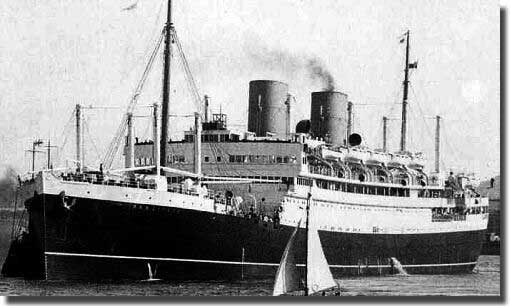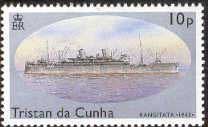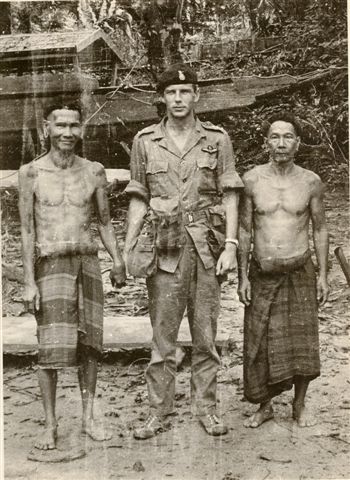|
Letters
April 1945, aboard Rangitata in the convoy CU-45 Dear Sir, When I was 10 my mother and I left New York in a convoy bound for the UK. The war in Europe ended whilst we were at sea. The actress, Gladys Cooper, was also on board. We often had to sleep in our clothes and one night I was called up on deck "to see a sight I would probably never see again." This was a tanker on fire from a u-boat. We just steamed on until the tanker was just a glow in the sky. I think the trip took about a month and I believe we steamed past the Azores, the Isles of Scilly, and then to Liverpool. My mother and I had left Bermuda in a flying boat at the end of January 1945. We arrived on the St Lawrence, New York. Then we went out to Indiana to see my brother who was with the Fleet Air Arm flying training on Harvards. He was scheduled for Japan and obviously my mother wanted to see her eldest son before he went. We returned by train to New York. I had had my tenth birthday in Kokomo Indiana so I was just ten. Then we got on the ship in New York and set off for the UK. I shall always remember parts of that trip. Is there any way of finding out more about that convoy? I must have seen just about the last ship sunk in the Atlantic in WW2. Best wishes,
Great to hear from you and what a fascinating letter. I thought you had posed me an impossible task, but of course the mention of the actress Gladys Cooper held the key.
I put her into Google leaving New York by ship in 1945 for Liverpool, and within seconds found she sailed from NY on the 3rd. of April
to arrive in Liverpool on the 20th. of April 1945. Your ship was Rangitata, the convoy On the 18th. of April, at 1015 in the morning ( your memory let you down here, the attack was not at night ) U-Boat U-1107, 70 miles west of Brest, France, under the command of Kptlt. Fritz Parduhn, fired a spread of three torpedoes, to sink the Liberty Ship Cyrus H. McCormack, from a crew of 47, 6 died. U-1107 attacked Convoy Ship Details Your tanker was Empire Gold. Ship Details The 4 survivors were picked up by the rescue ship Gothland ( Captain James Murray Hadden OBE ) and landed at Goorock Scotland on the 21st. of April. U-1107 received her comeuppance on the 30th. of April 1945, sunk with all 37 crew killed, in the Bay of Biscay was an American Catalina aircraft. I will send a photo of Rangitata and one of her appearing on a stamp separately. I had been married when a Lieutenant RAN in HMAS Shropshire in December 1945, and I was on my way to UK with the Australian Victory Contingent on board about May of 1946. I was to stay in England until early in 1948 to undertake a Long course to qualify as a Torpedo Anti-Submarine Specialist. My new wife was to follow as soon as a passage could be found, not easy at that period, by chance, she left Sydney for Tilbury in Rangitata in about August of 1946, what a coincidence. Hope this helps a little Arthur. Best Regards, Arthur, Rangitata, a photo for you, she had been built in 1929 by John Brown and Company Limited on the Clyde, a refigerated passenger ship of 16,737 tons. On the 4th. of December 1939 she was requisitioned as a personnel carrier and served as a passenger transport ship till 1941, when it was converted to a troopship with a capacity of 2,600 troops. She returned to civilian control on August 15, 1946.
Regards,
Finally, RANGITATA appears on a postage stamp (below). It was issued by the tiny island of Tristan da Cunha. Only 8 miles in diameter and lying in the Atlantic ocean some 1,500 miles from the nearest land, the island is surrounded by high sheer cliffs ranging up to 1,800 feet high. It's main feature is a volcanic peak that is covered in snow all year long. There is a very small community of some 300 people on one side of the island, and the rest of the island is utterly uninhabitable. One ship visits Tristan da Cunha every year in January. One can but wonder whether or not RANGITATA ever passed by.
Best wishes,
My brother, much to his disgust, never made it to Japan: the war ended. As for me, after school in 1953, I joined the Coldstream Guards for basic training, went to Sandhurst, was commissioned into the 4th Hussars, went flying with Army Air Corps and, as a Queen's Royal Irish Hussar (an amalgamation of 4th Hussars and 8th Hussars who both charged at Balaclava) served in Germany, Aden, Malaya and Sarawak. I took part in the 'confrontation' against Indonesia and we had 2 fine Australian officers with us, I believe from the Royal Australian Regiment, an affiliated regiment. Being up to date infanteers they were able to teach us pongoes a few basic tricks, though I never actually fired a shot in anger. It's a small world. The convoy: I was only just 10 years old, but I remember the hissing sound of the water as the ship ploughed on day after day. At night the nearby ships would appear to vanish in the night, but were always there the next day. On the actual sinking of the ship I am confused. I was called up from the cabin, which was shared by many, by a Mr. Carpenter, and I thought it was night or dusk. I seem to remember seeing a nearby ship on fire, so that was in daylight of sorts, but then I have a vision of just a glow. Obviously it was not night - amazing how one can get a memory wrong. The whole episode did affect me a little. I just won't watch films like "Titanic!" When my older brother, at about 17, left Bermuda, my father said, giving him a flask, "If your ship is hit, drink this, go off the high side and swim like hell." My father was a patriot who admired the English but thought them rather too reserved. When first over in London he wrote in his diary that the only people who would talk to him were policeman and the ladies of the night, great in number - but rather sad for a young Canadian far from home. I am really glad to have come across you, purely by chance, and what a marvellous job you do. Many thanks. I will send you a photo taken of me with 2 Iban, erstwhile headhunters in the 3rd Division, Sarawak; friends as you can see. One insisted on going round holding my hand - a little embarrassing at first (British reserve) but I got used to it. Self with 2 Iban or Sea Dyaks in Sarawak, 1962, during confrontation with Indonesia.
I remember also French sailors from the Surcouf with their pom pom hots. My brother tells me that this submarine, always rather suspicious as to which side it was on, was later rammed by an American war ship and lost. Unfortunately there were at least 2 RN officers on board. My brother at about 16 took me aged 6 on his bicycle to see HMS Duke of York, anchored off the island and wating to take WSC back to England. As a young 2nd Lieutenant I met our Honorary Colonel, WSC, when he came to visit the 4th Hussars, his old Regiment in Germany. I said,
Thanks to Drew Pritt, Little Rock, Arkansas for the following. The following
Thanks to Len for the correction: "RANGITATA-APRIL-1945, convoy was CU-65 not HX 348" |



